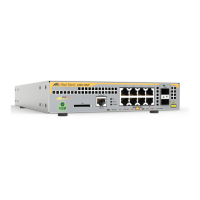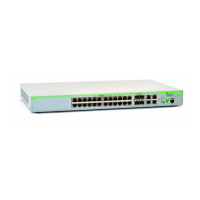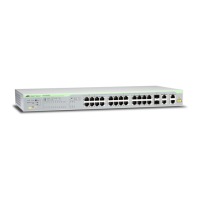C613-50100-01 REV C Command Reference for x930 Series 569
AlliedWare Plus™ Operating System - Version 5.4.6-1.x
SPANNING TREE COMMANDS
INSTANCE
VLAN (MSTP)
instance vlan (MSTP)
Overview Use this command to create an MST Instance (MSTI), and associate the specified
VLANs with it. An MSTI is a spanning tree instance that exists within an MST region
(MSTR).
When a VLAN is associated with an MSTI the member ports of the VLAN are
automatically configured to send and receive spanning-tree information for the
associated MSTI. You can disable this automatic configuration of member ports of
the VLAN to the associated MSTI by using a no spanning-tree mst instance
command to remove the member port from the MSTI.
Use the instance vlan command for MSTP only.
Use the no variant of this command to remove the specified VLANs from the MSTI.
Syntax
instance <instance-id> vlan <vid-list>
no instance <instance-id> vlan <vid-list>
Mode MST Configuration
Usage The VLANs must be created before being associated with an MST instance (MSTI).
If the VLAN range is not specified, the MSTI will not be created.
This command removes the specified VLANs from the CIST and adds them to the
specified MSTI. If you use the no variant of this command to remove the VLAN from
the MSTI, it returns it to the CIST. To move a VLAN from one MSTI to another, you
must first use the no variant of this command to return it to the CIST.
Ports in these VLANs will remain in the control of the CIST until you associate the
ports with the MSTI using the spanning-tree mst instance command.
Example To associate VLAN 30 with MSTI 2, use the commands:
awplus# configure terminal
awplus(config)# spanning-tree mode mstp
awplus(config)# spanning-tree mst configuration
awplus(config-mst)# instance 2 vlan 30
Parameter Description
<instance-id> Specify an MSTP instance in the range 1-15.
<vid-list> Specify one or more VLAN identifiers (VID) to be associated with
the MSTI specified. This can be a single VID in the range 1-4094,
or a hyphen-separated range or a comma-separated list of VLAN
IDs.

